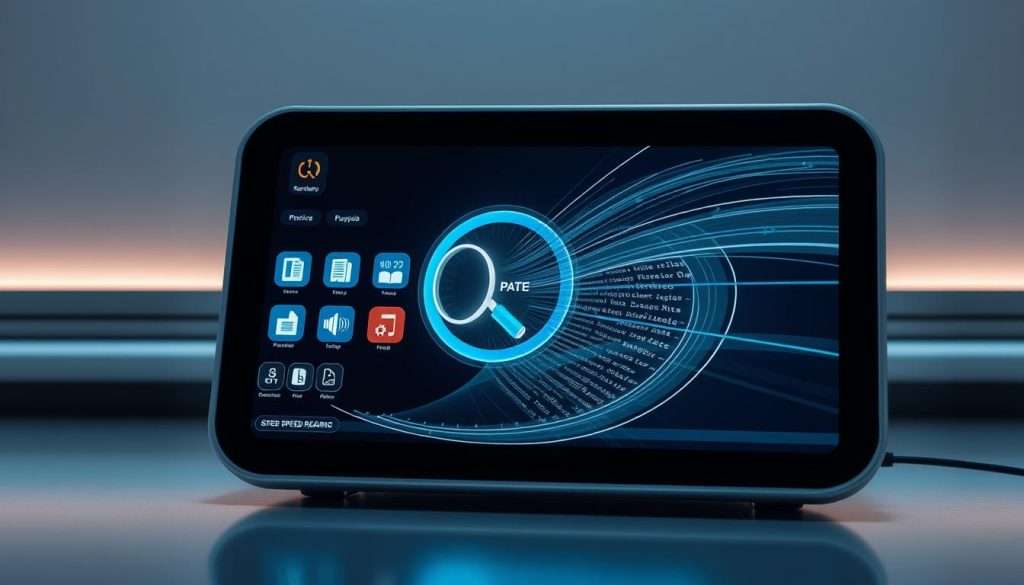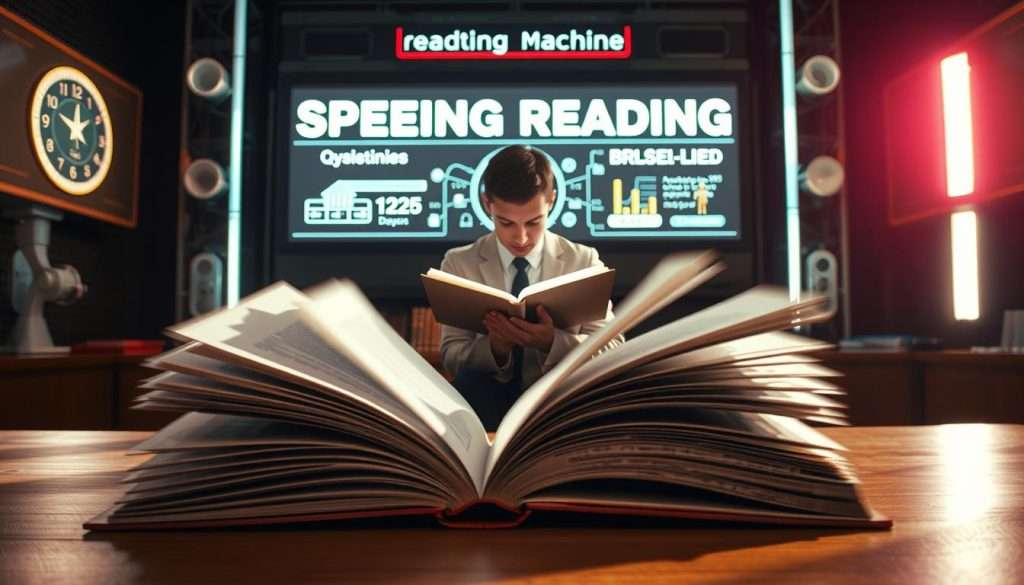In today’s fast world, we face a lot of information. To keep up, we must quickly process and understand this info. That’s why speed reading is key for better reading skills.
By improving your reading speed, you change how you learn and work. It’s not just about reading fast. It’s about getting and keeping information better. Speed reading is great for students and professionals alike.
Key Takeaways
- Discover the benefits of speed reading in today’s information-rich world.
- Learn how to improve your reading speed and comprehension.
- Understand how speed reading can enhance your personal and professional growth.
- Explore practical tips to get you started with speed reading.
- Transform your reading habits and unlock your full potential.
The Science Behind Reading Efficiency
Unlocking the secrets of speed reading starts with understanding how our brains process written information. You’ll learn it’s not just about reading fast. It’s about enhancing your ability to absorb and retain information.
How Your Brain Processes Written Information
When we read, our brains don’t just process words linearly. They actively work to understand the context, meaning, and relevance of the information. This complex process involves multiple cognitive functions, including perception, attention, and memory. By understanding how these functions work together, you can learn to optimize your reading technique.
Common Myths About Reading Speed Debunked
Many people have misconceptions about speed reading. Let’s debunk two common myths:
Myth: Speed Reading Means Skipping Content
Some believe that speed reading involves skipping over important details. However, effective speed reading techniques actually help you focus on the most relevant information. This ensures you grasp the main ideas without missing crucial points.
Myth: Speed Reading Reduces Comprehension
Another myth is that speeding up your reading rate comes at the cost of understanding. In reality, when done correctly, speed reading can increase reading comprehension. It trains your brain to process information more efficiently.
| Myth | Reality |
|---|---|
| Speed reading means skipping content | Effective speed reading helps focus on relevant information |
| Speed reading reduces comprehension | Speed reading can increase reading comprehension when done correctly |
By understanding the science behind reading efficiency and debunking these myths, you can approach speed reading with a clearer mindset. You’ll be ready to master speed reading techniques that truly work.
The Transformative Benefits of Speed Reading
Speed reading does more than save time. It changes how you take in information. By using speed reading strategies, you can boost your productivity and enjoy reading more.
Reclaim Valuable Time in Your Day
Speed reading lets you save a lot of time. You can read the same amount of material quicker. This means you have more hours for other things. It’s great for students and professionals who need to keep up with new information.
Enhance Information Processing and Retention
Speed reading makes you better at processing and remembering information. It trains your brain to take in info more efficiently. This way, you understand and remember more.
Sharpen Focus and Mental Stamina
Speed reading also boosts your focus and mental endurance. As you get better, you can stay focused longer without getting tired. Your brain gets better at handling information, making reading easier.
How Speed Reading Improves Concentration
Speed reading sharpens your concentration by focusing on the text’s key parts. It helps you avoid distractions and stay at a steady pace. This keeps your mind active and focused.
| Benefits | Description | Impact |
|---|---|---|
| Reclaim Time | Read faster, consume more in less time | More time for other activities |
| Enhance Processing | Improve comprehension and retention | Better understanding and recall |
| Sharpen Focus | Improve concentration and mental stamina | Less mental fatigue, more productivity |
Adding speed reading to your daily routine can change your life. It’s perfect for students wanting to do better or professionals wanting to stay on top of their game.
Measure and Benchmark Your Current Reading Abilities
To unlock your reading potential, you first need to understand where you stand. Measuring your current reading abilities is a crucial step. It’s about understanding your strengths and identifying areas for improvement.
Calculating Your Words Per Minute (WPM)
Calculating your WPM is a straightforward process. It gives you a clear benchmark of your current reading speed. To do this, you’ll need to select a text, read it for a minute, and then count the number of words you’ve read.
Step-by-Step WPM Testing Process
- Choose a text that you’re not familiar with.
- Read the text for exactly one minute.
- Count the number of words you’ve read.
- Repeat the process to ensure accuracy.
Establishing Your Comprehension Rate
While speed is important, comprehension is equally crucial. To test your comprehension, take a quiz on the material you’ve just read or summarize the main points. This will help you understand how well you’re retaining the information.
Setting Achievable Improvement Targets
Once you have your WPM and comprehension rates, you can set realistic targets for improvement. Start by setting small, achievable goals, and gradually increase them as you become more comfortable with speed reading techniques.
Breaking Bad Reading Habits
To unlock your true reading potential, it’s essential to break free from bad reading habits that slow you down. Bad habits like subvocalization, regression, and word-by-word reading can significantly impede your reading efficiency.
Eliminating Subvocalization Techniques
Subvocalization is the habit of pronouncing words in your head as you read. To overcome this, practice reading in groups of words or focus on the meaning of phrases rather than individual words. Our online speed reading course offers specific exercises to help you achieve this.
Reducing Regression and Backtracking
Regression involves re-reading text you’ve already gone over. To reduce this, try using a pointer (like a finger or a cursor) to guide your eyes as you read, ensuring you move forward without backtracking.
Overcoming Word-by-Word Reading
Reading word-by-word slows you down. To overcome this, practice taking in groups of words at a time. This is known as chunking.
Practical Exercises to Break the Word-by-Word Habit
Try this simple exercise: as you read, focus on taking in two to three words at a glance. Gradually increase the number of words as you become more comfortable.
| Exercise | Description | Benefit |
|---|---|---|
| Chunking | Read groups of words at a time | Improves reading speed |
| Guided Reading | Use a pointer to guide your eyes | Reduces regression |
| Phraze Reading | Focus on phrases rather than individual words | Enhances comprehension |
By incorporating these techniques into your daily reading routine, you’ll be well on your way to breaking bad reading habits and improving your overall reading efficiency.
Core Speed Reading Techniques for Beginners
Starting your speed reading journey is exciting. Learning the core techniques is key. These methods will boost your reading speed and understanding.
The Meta Guiding Method
The Meta Guiding Method uses a guide to help your eyes move smoothly. It’s great for beginners. It stops you from reading out loud and helps you stay on track.
Using Your Finger or a Pointer
Using your finger or a pointer is a simple way to start. It keeps your eyes focused and stops them from wandering. This makes reading smoother and faster.
Developing Smooth Tracking Movements
Smooth tracking is important for the Meta Guiding Method. Practice moving your pointer or finger at a steady pace. This builds your reading speed and stamina.
The Scanning Technique for Key Information
Scanning quickly finds important information in a text. Look for headings, subheadings, and bullet points. This helps you quickly understand the main ideas.
Strategic Skimming for Quick Overview
Strategic skimming gives you a quick overview of a text. Focus on key phrases and sentences. This way, you can quickly grasp the main themes.
Using these techniques daily will make you read faster and better. Remember, practice and being open to new methods are key to improving.
Advanced Speed Reading Strategies
Now that you’ve mastered the basics, it’s time to take your reading to the next level. To improve reading speed and increase reading comprehension, you’ll need to use more advanced techniques.
The Chunking Method: Reading in Groups of Words
The chunking method involves reading groups of words at once. This method can greatly boost your reading speed by reducing eye movement.
- Practice recognizing common word patterns and phrases.
- Focus on understanding the overall meaning rather than getting bogged down in individual words.
Expanding Your Peripheral Vision
Expanding your peripheral vision lets you see more at a glance. This can be done through exercises that increase your awareness of your surroundings and the text.
“The more you can expand your peripheral vision, the less you’ll need to move your eyes, thus increasing your reading speed.” – Expert Reader
The Schultz Table Technique
The Schultz Table Technique uses tables or grids to train your eyes to focus on multiple points at once. This can improve your ability to quickly take in information.
How to Practice with Schultz Tables
To practice with Schultz Tables, follow these steps:
- Find a Schultz Table online or create your own grid.
- Focus on the center of the grid and try to identify the numbers or letters in the periphery.
- Gradually increase the size of the grid as you become more comfortable.
The RSVP (Rapid Serial Visual Presentation) Method
The RSVP method shows text one word at a time quickly. This technique can help you improve reading speed by making your brain process information fast.

By using these advanced strategies, you can increase reading comprehension and boost your reading speed. Regular practice will lead to lasting improvements.
Daily Practice Routines to Triple Your Reading Speed
To really boost your reading speed, daily practice is key. It builds the skills and habits for reading fast and well.
5-Minute Speed Drills for Busy People
Even if you’re busy, you can still get faster with short drills. Spend 5 minutes a day on speed reading exercises like quick skimming or meta guiding. Start with a simple task: read a short piece and time yourself. Then, try to read it again faster, understanding as much as you can.
Progressive Training Schedule (Weeks 1-4)
For steady progress, use a structured plan. Here’s a 4-week example:
- Week 1: Practice meta guiding for 5 minutes daily
- Week 2: Increase meta guiding to 10 minutes and introduce skimming
- Week 3: Continue skimming and add rapid serial visual presentation (RSVP) for 5 minutes
- Week 4: Combine all techniques, gradually increasing duration
Tracking and Measuring Your Improvement
It’s important to track your progress to improve your speed reading. Keep an eye on your reading speed and how well you understand what you read.
Creating Your Personal Progress Journal
Keep a journal for your daily practice. Note the exercises, how long you did them, and any thoughts you have. Looking back at your progress will keep you motivated and help you adjust your routine as needed.
Maintaining Comprehension While Increasing Speed
When you read faster, it’s key to keep understanding what you’re reading. This balance is vital for effective speed reading.
Active Reading Techniques
Active reading helps you stay on track. It means asking questions, making summaries, and spotting important ideas. This way, you read not just quickly but also deeply.
- Ask questions about the material as you read
- Summarize key points in your own words
- Identify and highlight crucial concepts
Strategic Pausing for Complex Material
Some texts are harder to get through than others. When you hit a tough spot, take a moment to think about it. This pause helps you grasp the material better and avoid missing key points.
“The art of reading is not just about reading fast, but also about understanding deeply.”
When to Adjust Your Speed Based on Content Type
Not all texts are the same. Fiction can be read quicker than non-fiction or technical texts.
Reading Fiction vs. Non-Fiction
Fiction moves at a faster pace because of its story structure. Non-fiction, with its detailed info, needs a slower read.
Approaching Technical and Academic Texts
Technical and academic texts need a slower read. They have complex words and lots of info. Adjusting your speed is key to understanding.

Using these strategies, you can enjoy the benefits of speed reading without losing comprehension. It’s about finding the right balance and adapting your reading style.
Digital Tools and Resources to Support Your Speed Reading Journey
To boost your reading skills, check out digital tools and resources for speed reading. They help you stay focused, enhance your abilities, and read more efficiently.
Top Speed Reading Apps and Software
Many apps and software programs aid in your speed reading journey. Spreeder and 7 Speed Reading are favorites that offer training and exercises. They let you adjust reading speeds and test your comprehension.
Online Courses and Training Programs
Online courses provide structured learning and keep you motivated. Sites like Coursera and Udemy have courses on speed reading. These include video lessons, quizzes, and assignments to learn speed reading techniques.
Recommended Books for Further Study
If you like books, there are many great ones on speed reading. “The Speed Reading Book” by Tony Buzan is a top pick. It gives detailed advice on boosting your reading speed and understanding.
Conclusion: Transforming Your Reading Life
By using speed reading techniques, you can read faster, understand better, and save time. We’ve looked into the science of reading quickly, its benefits, and how to get better at it.
Starting your speed reading journey? Remember, practice every day is crucial. Use the routines and digital tools we talked about to keep track of your progress. You’ll be surprised at how much you can do when you read quicker and smarter.
Now, it’s your turn to change how you read. Start using speed reading techniques today. You’ll find yourself reading more efficiently and enjoying it more!

